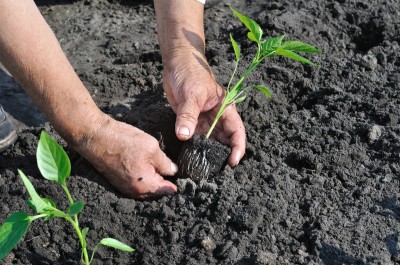
Image source: HarvestToTable
It’s almost June, and our greenhouse is exploding. Last fall we saved seeds from our heirloom flowers and veggies, started them in March, and now it’s time to transplant them from their home in the greenhouse to the raised beds outside, and boy are they ready.
Our nights are warmer, finally, bottoming out in the mid-50s, the perfect time to put all my baby plants into their permanent homes. After 3 years of trial and error, this is what I learned about transplanting times and procedures:
1. Some plants can go outside early. Veggies like snap peas, broccoli, onions, carrots, leeks, lettuce and potatoes can go in the garden while the nights are in the 30s, and most of these can even handle a soft frost. Carrots, radishes, lettuce, and leek seeds can go straight to the garden, but onions, green beans, broccoli and snap peas need to be started early in the greenhouse here in northern Illinois. Otherwise, by the time these veggies start growing produce the weather is so hot that the plants shoot up and the fruit suffers. With broccoli, beans and peas, you will have a very short season. Our first year, we planted seeds directly into the raised beds, and the broccoli never even produced a head, and we only got a few weeks of beans and peas before it got too hot for them.
New Survival Seed Bank™ Lets You Plant A Full Acre Crisis Garden!
Other plants shouldn’t go out until the ground temperature stays above 55 degrees. Tomatoes will just stop growing if you put them in cold ground. Melons can and should be started in the greenhouse, and planted outside when the ground stays above that magic 55 degrees.
2. Plant vertical on the north side of your garden.
Climbing plants like snap peas, cucumbers, and green beans can be put in the north end of your garden using lattice, fencing, or even hog panels for them to climb on. This keeps all your veggies in the same space, and for those of you with small areas to plant, this is a great space-saving technique.
Story continues below video
3. Keep a close eye on your transplants.
Those first few days after your plants go outside, check on them a few times each day. If a plant wilts, give it some water. The ground all around the plant may be wet, but the roots have not found that water just yet. If the edges of your plant leaves turn light brown or yellow, you’re probably watering too much. Just poke your finger in the soil right next to the roots to check for moisture. Learn the difference between what a plant looks like when it is too wet and too dry. Remember, these baby plants are used to being in a warmer, less windy greenhouse, so watch them closely. If you jumped the gun, planting early, the leaves will tell you. The tops and outer edges of the plant will curl up and whither if they get too cold. Just put a plastic dome over them until they come out of it.
4. Harden your plants.
We turn the temps down in the greenhouse for a few days just before transplanting, sometimes even leaving flats outside overnight. This helps prepare them for their final trip to the garden.
5. Use your greenhouse after the plants are gone.
We start tomatoes, beans, peas, cucumbers and melons directly into the soil inside the north end of our greenhouse, just a couple of each plant. This gives us veggies by the end of May, and the melons string out along the inside of the greenhouse, on the outside edge, loving every minute of their home.
These are just a few of the tricks we have learned about transplanting from greenhouse to garden. I would love to hear more about your gardening tricks, as we are just starting to learn to take advantage of our greenhouse. Let me know your ideas in the comments section below.
Sign up for Off The Grid News’ weekly email and stay informed about the issues important to you
 Off The Grid News Better Ideas For Off The Grid Living
Off The Grid News Better Ideas For Off The Grid Living




